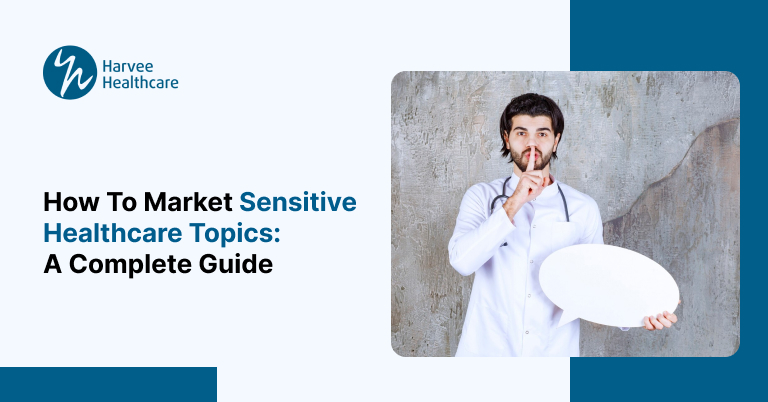
How to Market Sensitive Healthcare Topics: A Complete Guide
The article discusses the difficulties of discussing delicate medical subjects with patients. It emphasizes how important it is for medical marketing to concentrate on the wants and needs of patients.
A combination of professionalism, precision, and care is required when marketing delicate healthcare subjects. Sharing information in a way that respects patients and fosters their trust is just as important as providing it.
Patients can feel more supported and have an easier time understanding complex healthcare services with the use of simple and well-considered solutions.
Top 8 Strategies on How to Market Sensitive Healthcare Topics
1. Understanding Sensitive Healthcare Topics
People tend to avoid discussing common health problems like lice, constipation, warts, and rashes because they feel awkward or ashamed about them.
But in order to increase awareness and guarantee that individuals receive the proper care, it’s critical to have an open conversation about these issues.
Understand the viewpoints and cultural sensitivities of your audience:
Spend some time getting to know the history and experiences of your audience. This facilitates the development of connection and trust by enabling you to speak in a way that feels considerate and applicable to their needs.
Avoid fear-based or excessive messaging:
Avoid using fear tactics that could spread anxiety. Rather, concentrate on providing clear and comforting information that gives your audience the confidence to act.
Pay attention to establishing trust and providing assistance:
Take a kind and understanding approach. Make sure your audience understands that they are not alone in seeking the care they require and that they are encouraged to do so.
2. Focus on Providing Accurate and Reliable Information:
Sharing accurate information is crucial when it comes to healthcare. Inaccurate or false data could damage both your reputation and the confidence of your target audience. Providing trustworthy, current information that empowers people to make health-related decisions is crucial.
Use data from credible healthcare organizations:
Always use reliable sources, such as reputable medical journals, government health websites, and well-known health groups. These are the sources you turn to when you want reliable and accurate information.
Work with healthcare professionals to validate your content:
Assemble a group of doctors or other healthcare specialists to verify your content twice. Their background can ensure that the information you provide is correct, relevant, and genuinely beneficial to your audience.
Regularly update your content to the most recent findings:
Since the healthcare industry is constantly changing, it’s critical to maintain the relevance of your material.
Make sure your audience has access to the most recent information by updating it frequently to reflect the most recent findings and available treatments.
3. Respect Privacy and Compliance:
As a healthcare provider, it is critical to adhere to industry laws to ensure your marketing is both legal and ethical.
By being compliant, you not only line up with best practices but also enhance your patients’ confidence and loyalty, which are critical goals for any effective patient marketing campaign.
Avoid disclosing identifiable patient information without consent:
Prior to using any identifiable patient information in your marketing, always obtain express consent. Preserve patient privacy while making sure laws like GDPR and HIPAA are followed.
Include disclaimers where needed:
To maintain transparency, provide clear disclaimers, particularly when discussing medical data or findings. Disclaimers help to reduce legal risks and manage expectations.
4. Make Use of Content Creation:
One of the best ways to establish trust and demonstrate your brand’s commitment is to share information that is clear and helpful. You can address concerns, provide answers, and establish a meaningful connection with your audience by producing blogs, films, infographics, and webinars.
Responding to Frequently Asked Questions
Create movies or blogs that provide straightforward explanations of topics, including expenses, procedures, and recovery steps. This removes doubts and boosts confidence.
Detailed Instructions
Use movies or infographics to simplify care routines or therapies. This makes it simple to follow and comprehend complicated material.
To showcase your experience and establish an emotional bond with your audience, share brief expert interviews or true patient stories.
5. Select Visuals Carefully
Visuals are an effective tool for communicating with others and presenting your message. But when it comes to delicate subjects, it’s crucial to pick them carefully. While the wrong images could make someone uncomfortable or misunderstood, the right ones can offer clarity and hope.
Choose Positive and Reassuring Images
Consider the feelings that your viewers will have after viewing your images. Make use of pictures that evoke feelings of comfort and hope, such as happy faces, soft shades, or representations of healing and growth.
Use Infographics to Simplify Concepts
Some subjects seem too much to handle. Complex information can be simplified into easily understood pictures with the use of infographics. Infographics can greatly clarify any type of information, including data, timelines, and processes.
Ask for Feedback First
Get feedback from a small group of people before releasing your images to a larger audience. This guarantees that your photos convey the intended meaning and don’t inadvertently trigger negative reactions.
6. Use an Empathetic Approach
The foundation of good communication, particularly when discussing sensitive topics, is empathy. You create a more natural connection with your audience than just sharing information when you demonstrate that you genuinely understand the challenges they face.
Use polite and considerate language:
Select words that convey respect, kindness, and understanding. Create a friendly and encouraging environment for your audience by using language that makes everyone feel appreciated and secure.
Share Real Stories and Experiences:
Talk about the real-life experiences of people who have faced similar challenges. Listening to someone else’s story will help your audience believe that you truly understand what they’re going through and make them feel less alone.
7. Using Digital Channels for Patient Engagement:
There are easy strategies to maintain contact and engagement with your patients through digital marketing. You can reach more individuals and create closer, lasting relationships with the use of tools like online webinars, SEO-optimized websites, and email newsletters.
Email newsletters
Email newsletters are a fantastic method to inform your patients and demonstrate your concern for their health by sharing news, advice, and significant updates from your clinic.
SEO-Friendly Websites
SEO-Friendly Websites ensure that patients can discover you online more easily when they’re looking for trustworthy healthcare information, allowing them to get the assistance they require.
Online Webinars:
Online Webinars allow you to interact with patients, providing unique insights on health topics and directly addressing questions, which helps to promote trust and connection.
8. Use Social Media Marketing with Caution:
Social networking is an excellent strategy to connect with others, but be cautious, especially when discussing sensitive topics. Maintaining a professional and understanding tone can assist your audience in having a positive and supportive experience.
Tell Stories to Connect with Your Audience:
Share genuine, meaningful experiences that will connect with your audience. Whether it’s a patient’s accomplishment or a personal experience, narrative brings your information to life and builds an authentic emotional connection.
Pay Attention to Comments and Responses to them:
Connecting with people is the main goal of social media, so it’s critical to pay close attention to what they have to say, particularly when it’s a sensitive topic.
React swiftly, politely, and with language that conveys respect and empathy.
Taking the time to thoughtfully reply to your followers thoughtfully demonstrates your genuine interest in their issues and creates a closer, more trustworthy relationship.
Why Sensitivity Matters in Healthcare Marketing?
When marketing to patients, sensitivity is essential, particularly when talking about tough health issues.
If we are not careful, our communications may unintentionally anger patients, causing them to lose trust and become less eager to interact with us.
Empathic and respectful communication improves patients’ quality of life, according to studies. Following healthcare marketing regulations also ensures that we satisfy our patients’ expectations, which leads to greater results.
When people feel valued, they are more willing to work with healthcare professionals who honestly care. Additionally, thoughtful messaging can enhance a patient’s emotional and mental health, which will increase their level of pleasure.
Bottom Line:
Successful marketing requires handling sensitive healthcare subjects. Healthcare marketing is always changing, so it’s important to stay up-to-date.
As technology advances, so do the communication choices of patients. In order to continue satisfying patient needs, strengthening relationships, and contributing to improved health outcomes, marketers must remain adaptable and active.
Search
Recent Post
Categories
- AI in Healthcare
- Content Marketing
- Dental
- dental Digital Marketing
- Google Ads
- Google my business
- Healthcare marketing
- Healthcare SEO
- Internet Marketing Tips
- Lead Generation
- Local SEO
- Patient Satisfaction
- pay per click
- Pharma Marketing
- Social
- Social Media Marketing
- Traffic
- Website
- Website Designing
Contact
Get in Touch With Us
Coimbatore Address
- 21/1, Periasubbanna Gounder Street, K.K.Pudur, Coimbatore, Tamil Nadu 641038.
- 098942 76263
- info@harveehealthcare.com

Chennai Address
- RMZ Millenia Business Park, Level 6, Phase II, Campus 4B Unit 602A, Kandancavadi, Perungudi, Chennai, Tamil Nadu 600096.
- 098942 76263
- info@harveehealthcare.com

Dubai Address
- Umm Sequeim 3, Jumeirah Rd Opposite Burj Al Arab, Villa #1 855 A Dubai.
- info@harveehealthcare.com

United Kingdom Address
- 3/2 Powderhall Rigg Edinburgh, United Kingdom EH7 4GA.
- info@harveehealthcare.com

Copyrights © 2025 harvee.co.uk










